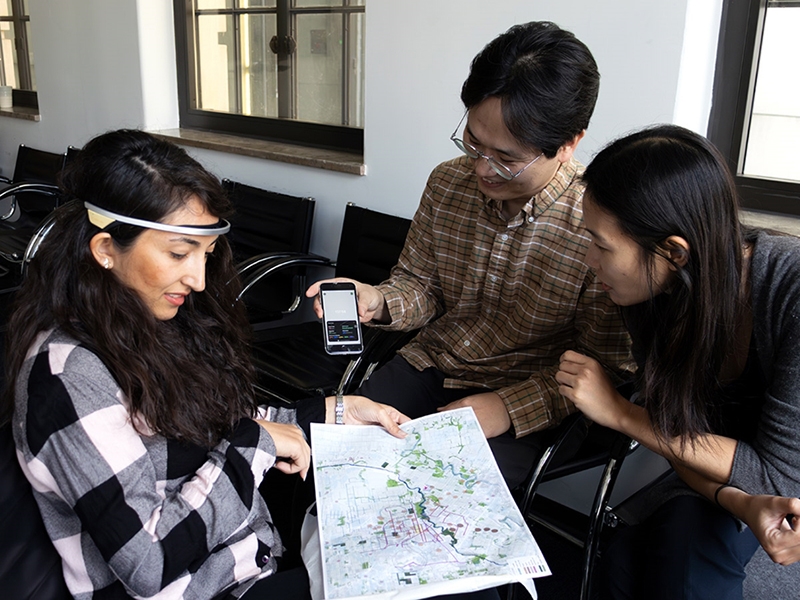
The Department of Interior Architecture and Design at the Fay Jones School of Architecture and Design in partnership with Corgan has been awarded a $30,000 grant from the AIA Upjohn Research Initiative. The grant, which is the maximum amount awarded, will be used to explore the design of workplaces for people with inattentive type attention-deficit/hyperactivity disorder, or ADHD.
The AIA Upjohn Research Initiative supports applied research projects that enhance the value of design and professional practice knowledge. The program funds up to six research grants annually for projects completed within an 18-month period.
"This research project is exactly what we want our faculty to be doing as a land-grant institution. It will use cutting-edge technology to address real-world problems in collaboration with one of the top 10 architecture and design firms in the nation," said Carl Matthews, professor and head of the Department of Interior Architecture and Design.
The grant will allow the principal investigators and collaborators, Jinoh Park, Melissa A. Hoelting, Samantha S. Flores, Michelle Huh and Marjan Miri to bridge academia and practice by collaborating to uncover design insights for those with inattentive type ADHD. Those with this type of ADHD struggle with paying attention to details, are easily distracted, often have trouble organizing or finishing tasks and often forget routine chores. By merging practical expertise with academic rigor, the researchers plan to develop real-world solutions for working populations with inattentiveness by enhancing their work environment.
Park, assistant professor of interior architecture and design at the Fay Jones School, met Hoelting, associate and senior design research lead at Corgan, when they presented their research at the Environmental Design Research Association last summer. The two brought on Flores, vice president and director of Hugo at Corgan, along with Huh and Miri, both assistant professors of interior architecture and design at the Fay Jones School. In addition to aiding in the research, the partnership provides sites and design advisers for the proposed experimentation.
The team is excited to use the grant to conduct hands-on field research at a Corgan office with the integration of wearable neurofeedback technology while in the built environment. Park said that, through an environmental focus on the workplace, this research aims to quantify the design's potential impact on those with an inattentive type of ADHD.
"Determining causality and correlation between experimental factors and neurofeedback data may be challenging," Park said. "Based on previous research achievements, we are challenging ourselves to enter a controversial area, not in a laboratory but in the real world."
This study seeks to understand how base design and tunable options can empower individuals to improve attentiveness in an office environment through a mixed methods approach, layering quantitative and qualitative methods. Park said that even if the research cannot produce generalizable findings, the team plans to generate hypotheses for subsequent studies.
The team will identify a defined set of design elements (such as sound, lighting, movement and visual distraction) that most impact the experience of the inattentive type ADHD population in the office environment.
Participants will be recruited from the general public, identifying challenges with inattentiveness or a diagnosis of ADHD. To run the experiment, participants will wear an electroencephalograph device to measure neurofeedback before, during and after using their identified space. The neurofeedback will be analyzed using event-related potentials, which measure the beginning and ending timing of tasks, and time-frequency, which measures the frequency and duration of task engagement. The results of the collected brain responses indicate employees' engagement in their workplace, regardless of their abilities. During that time, they will also complete questionnaires at multiple points during their tasks. These findings will be layered with qualitative insights from researcher observations to identify the impact of design in the workplace and make recommendations for overall workplace design.
Based on the results, the team will analyze how effectively the design elements in each space type can respond to the frequency, duration and cycle of the state of inattention. The study aims to demonstrate how to implement a work environment that encourages employees to perform at their best. Following the project, the team will create a workplace design guidebook for workplaces and designers who want to accommodate those with inattentive type ADHD.
The grant research will mainly occur this summer, with the presentation and final report of the research expected in 2025.
Topics
Contacts
Tara Ferkel, communications specialist
Fay Jones School of Architecture and Design
479-575-4704, tferkel@uark.edu
Michelle Parks, director of communications
Fay Jones School of Architecture and Design
479-575-4704, mparks17@uark.edu